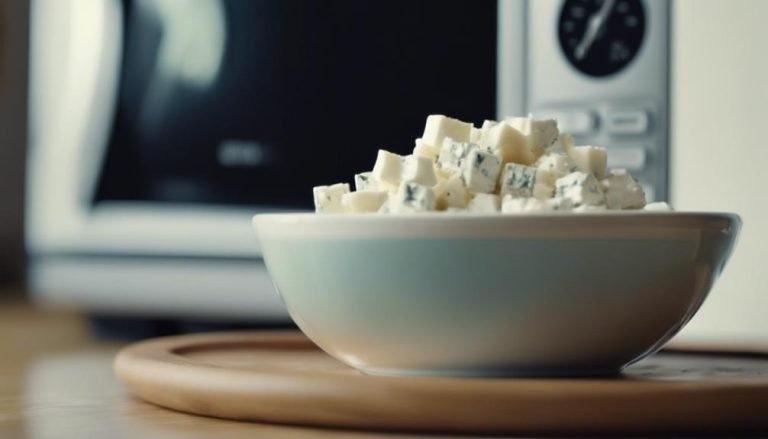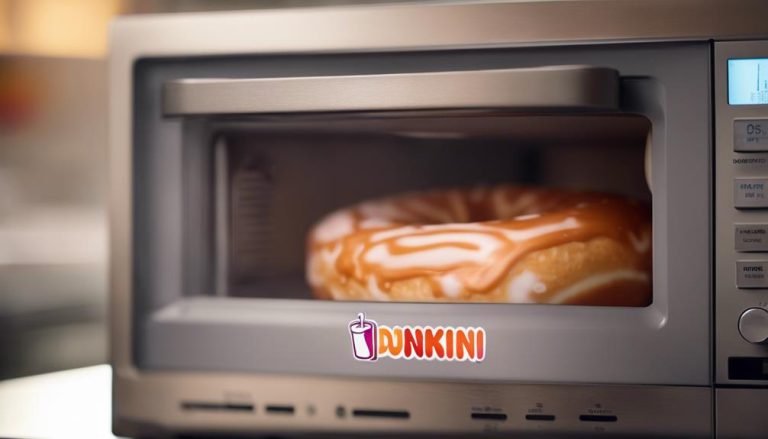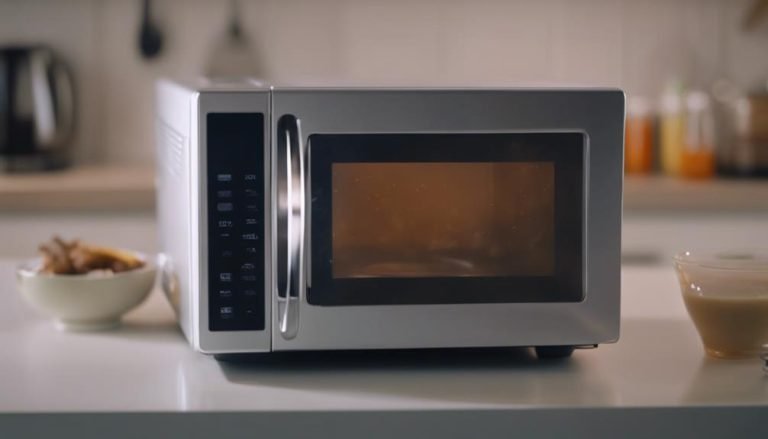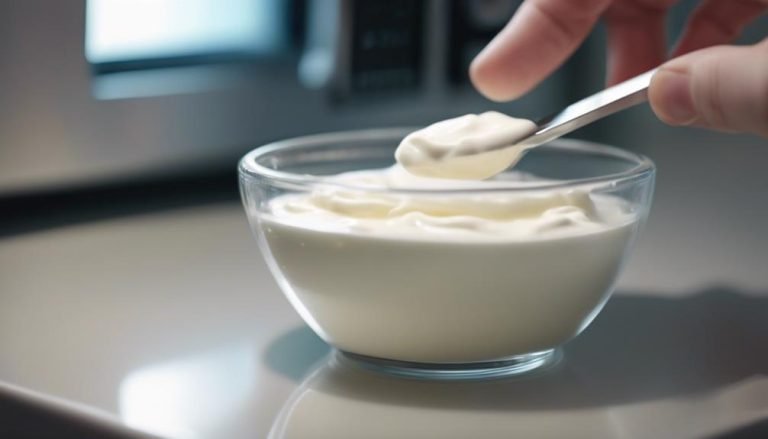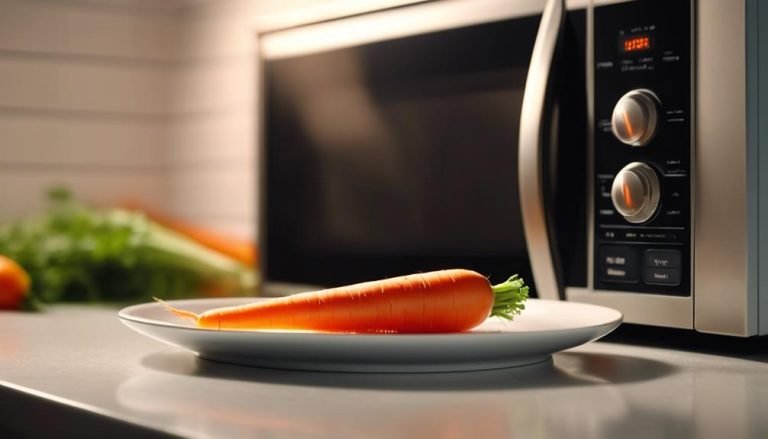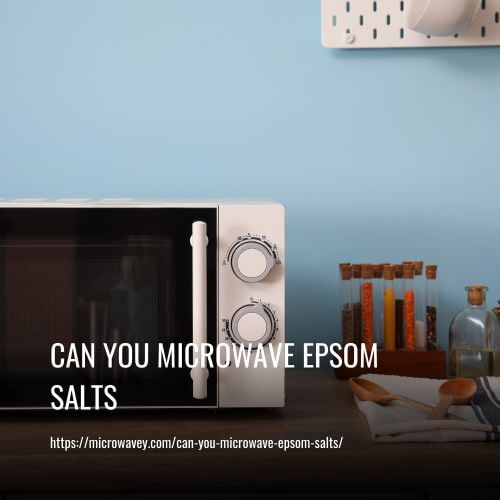Can You Microwave Dog Food
Yes, you can microwave dog food. Microwaving dog food can help warm it up, making it more appealing and easier to digest for your furry friend.
However, it is important to note that microwaving can cause uneven heating, potentially creating hot spots that can burn your dog's mouth. Additionally, some nutrients in the food may be lost during the heating process.
To ensure your dog's safety and maintain the nutritional value of their food, it is best to follow the manufacturer's instructions for heating or consider alternative methods such as using warm water or a slow cooker.
Key Takeaways
- Microwaving wet dog food can be safe if done correctly.
- Consider nutrient preservation and safety implications.
- Avoid microwaving dry dog food to maintain texture and taste.
- Following recommended heating times preserves food's nutritional value.
Safety Considerations for Microwaving Dog Food
When microwaving dog food, it is crucial to consider safety implications due to potential risks associated with the heating process. Uneven heating can lead to hot spots, risking burns or altering the food's consistency.
However, beyond safety concerns, microwaving dog food can also impact important nutrients. Nutrient loss is a significant issue, potentially affecting the overall nutritional value of the food.
Moreover, the molecular structure of the food may be altered during the microwaving process, further impacting its quality. Additionally, using plastic containers for microwaving can introduce harmful chemicals into the dog food, posing health risks.
Therefore, understanding these safety considerations is essential when deciding whether to microwave dog food.
Impact of Microwaving on Nutrients
Microwaving dog food raises concerns about nutrient loss, potential uneven heating, and the impact of chemicals from plastic containers on the food's quality.
Heating pet meals in a microwave may alter the molecular structure of the food, affecting its nutritional value.
Exploring alternative cooking methods like slow cooking, steaming, raw feeding, baking, or boiling can help preserve essential nutrients in dog food.
Nutrient Loss Concerns
The alteration of molecular structures and depletion of essential enzymes and vitamins in dog food can result from the process of microwaving, raising concerns about potential nutrient loss.
When microwaving wet dog food, the high temperatures can lead to the denaturation of proteins and degradation of vitamins and enzymes essential for your pet's health. The rapid and uneven heating process of microwaves can further exacerbate the nutrient loss, impacting the overall nutritional value of the food.
Compared to other cooking methods, microwaving may pose a greater risk of nutrient depletion due to the intense heat exposure. It's crucial to consider these nutrient loss concerns when deciding whether to microwave your dog's food to ensure they receive the necessary nutrients for their well-being.
Heating Time Effects
Excessive exposure to high temperatures during the heating process can significantly impact the nutrient content of dog food when microwaving. When considering how to heat your dogs' food, the duration of microwaving plays a crucial role in preserving the nutritional value.
Here are some effects of heating time on dog food:
- Prolonged microwaving can lead to a greater loss of essential vitamins and minerals.
- Quick heating in the microwave may alter the molecular structure of the dog food, potentially reducing its nutritional benefits.
- Enzymes vital for digestion and nutrient absorption in dog food can be compromised with extended microwaving.
- Research indicates that microwaving dog food might result in a lower overall nutrient content compared to other heating methods.
- Monitoring the microwaving time can help maintain the nutritional quality of your dogs' meals.
Microwaving Pet Meals
Minimizing exposure to high temperatures is crucial when heating pet meals in order to preserve the nutritional integrity of the food. When it comes to microwaving dog food, it's essential to be mindful of the potential impact on nutrients.
The molecular structure of dog food can be altered during the microwaving process, leading to potential nutrient loss. Additionally, microwaves may cause uneven heating of pet meals, further affecting the overall nutritional value.
Moreover, there is a risk of chemicals from plastic containers leaching into the dog food when microwaved, which can be harmful to pets. Considering these factors, pet owners should be cautious when using microwaves to heat their dog's meals to ensure their furry friends receive the necessary nutrients for optimal health.
Best Practices for Heating Dog Food
When heating dog food, consider employing alternate methods to retain nutritional integrity and cater to your pet's preferences.
- Slow Cooker: Slow cooking can help maintain the nutrients in the dog food while enhancing flavors.
- Steaming: Steaming dog food is a gentle method that helps preserve nutrients and can be appealing to picky eaters.
- Raw Feeding: Some pet owners opt for raw feeding, which involves feeding uncooked meat, bones, and organs to dogs.
- Baking: Baking dog food can help retain nutrients and create a crunchy texture that dogs may enjoy.
- Boiling: Boiling dog food is a simple method that can help kill bacteria and make the food easier to digest for some dogs.
Common Mistakes to Avoid
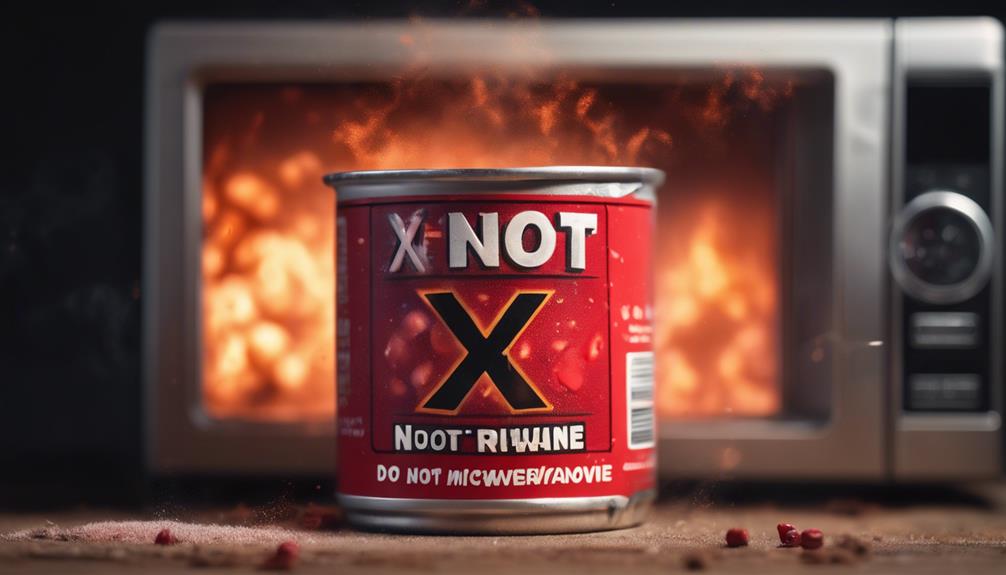
To ensure the proper handling of dog food during heating processes, it is crucial to be mindful of common mistakes that should be avoided.
Firstly, it is advisable to avoid microwaving dog food in plastic containers as this can lead to chemicals leaching into the food. Additionally, microwaving the food for too long should be avoided to prevent uneven heating and nutrient loss.
It is also essential to use caution when microwaving dog food to prevent altering the molecular structure of the food. Considering that dogs may be sensitive to electromagnetic radiation from microwaves, it is best to opt for alternative heating methods such as slow cooking, steaming, baking, or boiling to prepare their food without using a microwave.
Benefits of Microwaving Dog Food
While it is important to be cautious of common mistakes when handling dog food in the microwave, there are notable benefits to consider as well. Microwaving dog food can enhance the overall meal experience for your furry friend, especially by providing a warm meal that offers various advantages:
- Enhances aroma and flavor, appealing to picky eaters.
- Provides a warmer meal during cold weather.
- Increases dogs' excitement about mealtime.
- Adds a special treat element to their diet.
- Some brands offer specific microwaving instructions for optimal serving preferences.
Alternative Heating Methods for Dog Food
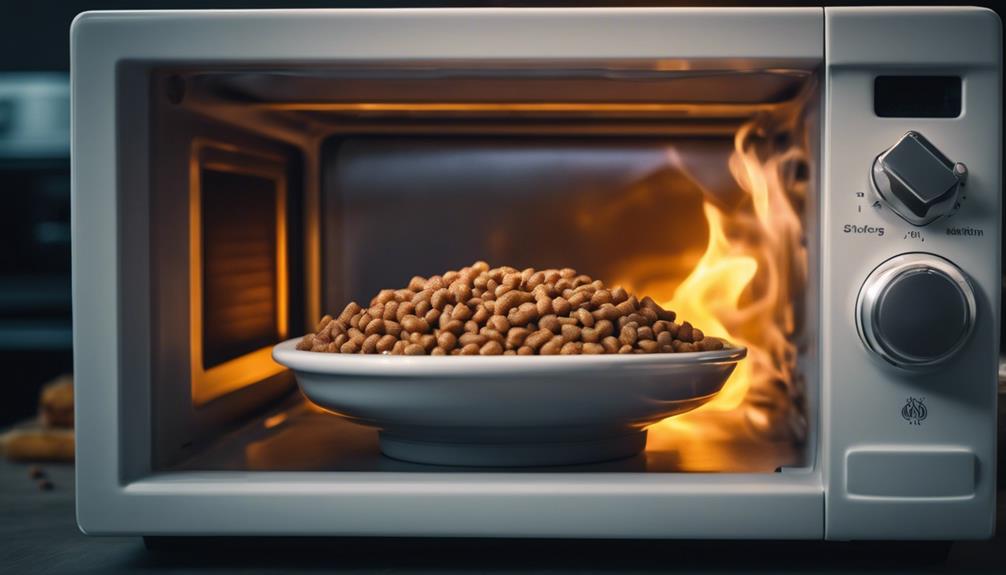
What are some alternative heating methods that can be utilized for preparing dog food, aside from microwaving?
Boiling water is a simple yet effective method of cooking dog food without the need for a microwave.
Additionally, using a slow cooker can gently cook dog food while maintaining essential nutrients.
Steaming is another healthy option that helps retain enzymes and nutrients critical for your dog's health.
Raw feeding provides a complete and balanced diet rich in nutrients, although it requires careful planning and consideration.
Baking dog food in the oven is a safe alternative to microwaving, ensuring that the food is cooked thoroughly.
These alternative methods offer diverse ways to prepare your dog's meals without the use of a microwave.
How Microwaving Affects Food Texture
Microwaving dog food can significantly impact its texture, potentially leading to uneven heating and changes in palatability for pets due to moisture loss and overheating. When considering how microwaving affects food texture, several key points should be taken into account:
- Uneven heating can result in some parts being too hot while others remain cold.
- The texture of the food may change, altering its palatability for pets.
- Moisture loss during microwaving can affect the overall texture and consistency of the dog food.
- Overheating can make the food mushy or rubbery, impacting its appeal to pets.
- Monitoring the microwaving process is crucial to maintain the desired texture for your pet's food.
Microwaving Wet Vs. Dry Dog Food
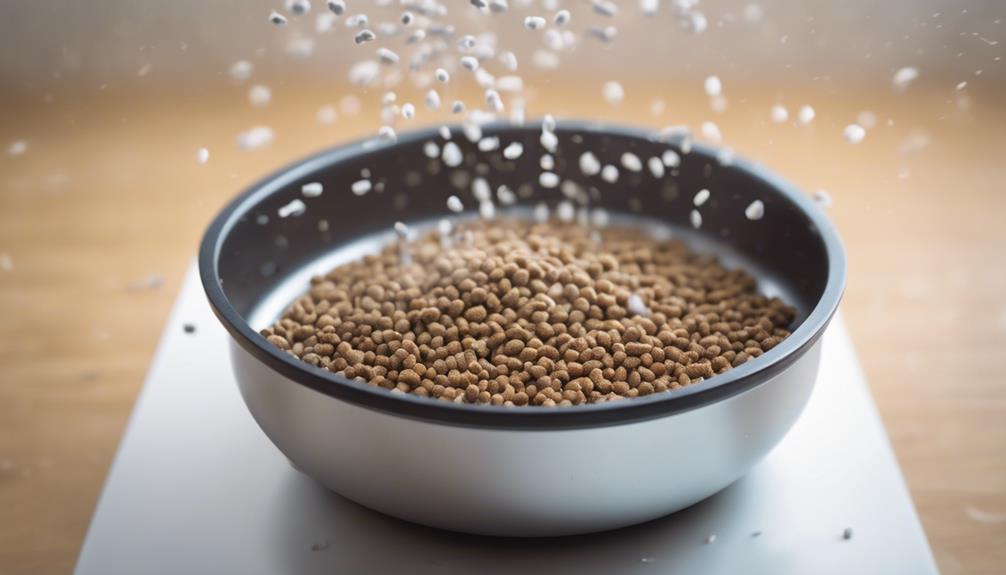
When considering microwaving wet versus dry dog food, it is essential to prioritize safety when heating wet food to prevent bacterial growth and ensure it is thoroughly warmed.
On the other hand, reheating dry dog food should focus on maintaining its texture and preventing it from becoming overly dry or unappetizing for the dog.
Understanding the specific needs of each type of dog food and following proper heating guidelines can help owners provide their pets with a safe and enjoyable mealtime experience.
Wet Food Safety
Heating wet dog food can enhance its appeal to picky eaters by improving aroma and flavor. Some key points to consider when microwaving wet dog food include:
- Certain wet dog food brands offer specific microwave instructions for heating their products.
- Microwaving can be a special treat for dogs, especially during colder seasons.
- Dogs may have varying preferences, with some enjoying cold food and others preferring warmed meals.
- Properly mixing wet dog food before microwaving is essential to prevent hot spots and ensure even heating.
- It is crucial to follow recommended heating times to avoid overheating and to preserve the nutritional value of the food.
Dry Food Reheating
Dry dog food should not be reheated in a microwave due to potential alterations in texture and taste as well as the risk of uneven heating and nutrient loss.
Unlike wet pet food, microwaving dry dog food can lead to changes that may not be appealing to your pet. Additionally, heating dry pet food in a microwave can create hot spots, which can burn your pet's mouth.
To soften dry dog food, consider adding warm water instead of using a microwave. It is crucial to follow the manufacturer's instructions on how to properly prepare and serve dry pet food to ensure your furry friend receives the necessary nutrients without compromising their meal's quality.
Frequently Asked Questions
Can Microwaving Dog Food Cause It to Spoil Faster?
Heating dog food in a microwave may lead to faster spoilage. Microwaving can create uneven heating, forming hot spots that encourage bacterial growth. Rapid multiplication of bacteria in improperly heated dog food can cause spoilage, posing health risks to pets.
Is It Safe to Microwave Dog Food in Its Original Packaging?
Microwaving dog food in its original packaging may pose safety risks due to potential chemical leaching. Transfer the food to a microwave-safe container for heating to ensure pet safety. Follow packaging instructions or consult the manufacturer for safe guidelines.
Can Microwaving Dog Food Change Its Flavor or Smell?
Microwaving dog food can alter its flavor and smell due to temperature changes that impact the food's composition. Microwave safety is crucial to prevent overheating and ensure proper mixing to evenly distribute heat and preserve the meal's nutritional value.
Are There Any Specific Types of Dog Food That Should Not Be Microwaved?
Certain types of dog food, such as raw, wet with bone fragments, or those containing specific ingredients like garlic or onions, should not be microwaved due to nutrient loss, potential hazards, or toxicity risks. Microwaving kibble can also alter its texture and nutritional value.
Can Microwaving Dog Food Affect Its Digestibility for Dogs With Sensitive Stomachs?
Microwaving dog food can alter its molecular structure, potentially impacting digestive health for dogs with sensitive stomachs. Uneven heating may affect consistency and nutrient composition, leading to gastrointestinal issues. Opt for alternative warming methods to maintain nutritional integrity.
Conclusion
In the culinary ballet of preparing dog food, the microwave may play a discordant note, altering the nutrient composition and potentially harming our furry companions.
To ensure a harmonious symphony of health and well-being, it is best to explore alternative methods such as slow cooking or baking.
By consulting with a knowledgeable veterinarian, we can orchestrate a meal that nourishes both body and soul, leaving tails wagging in delight.

